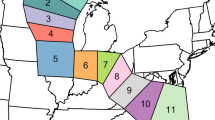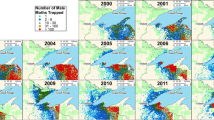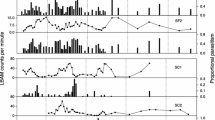Abstract
Allee effects have been applied historically in efforts to understand the low-density population dynamics of rare and endangered species. Many biological invasions likewise experience the phenomenon of decreasing population growth rates at low population densities because most founding populations of introduced nonnative species occur at low densities. In range expansion of established species, the initial colonizers of habitat beyond the organism’s current range are usually at low density, and thus could be subject to Allee dynamics. There has been consistent empirical and theoretical evidence demonstrating, and in some cases quantifying, the role of Allee dynamics in the gypsy moth, Lymantria dispar (L.), invasion of North America. In this review, we examine the potential causes of the Allee effect in the gypsy moth and highlight the importance of mate-finding failure as a primary mechanism behind an Allee effect, while the degree to which generalist predators induce an Allee effect remains unclear. We then explore the role of Allee effects in the establishment and spread dynamics of the gypsy moth system, which conceptually could serve as a model system for understanding how Allee effects manifest themselves in the dynamics of biological invasions.







Similar content being viewed by others
References
Allee WC (1932) Animal aggregations: a study in general sociology. University of Chicago Press, Chicago
Andow DA, Kareiva PM, Levin SA, Okubo A (1990) Spread of invading organisms. Landscape Ecol 4:177–188. doi:10.1007/BF00132860
Barbosa P, Greenblatt J (1979) Suitability, digestibility and assimilation of various host plants of the gypsy moth, Lymantria dispar L. Oecologia 43:111–119. doi:10.1007/BF00346676
Barbosa P, Gross P, Provan GJ, Stermitz FR (1990) Allelochemicals in foliage of unfavored tree hosts of the gypsy moth, Lymantria dispar L. J Chem Ecol 16:1731–1738. doi:10.1007/BF01014104
Berec L, Angulo E, Courchamp F (2007) Multiple Allee effects and population management. Trends Ecol Evol 22:185–191. doi:10.1016/j.tree.2006.12.002
Beroza M, Knipling EF (1972) Gypsy moth control with the sex attractant pheromone. Science 177:19–27. doi:10.1126/science.177.4043.19
Bess HA, Spurr SH, Littlefield EW (1947) Forest site conditions and the gypsy moth. Harv For Bull 22
Bierl BA, Beroza M, Collier CW (1970) Potent sex attractant of the gypsy moth: its isolation, identification and synthesis. Science 170:87–89. doi:10.1126/science.170.3953.87
Brockerhoff EG, Bain J, Kimberley M, Knížek M (2006) Interception frequency of exotic bark and ambrosia beetles (Coleoptera: Scolytinae) and relationship with establishment in New Zealand and worldwide. Can J Res 36:289–298. doi:10.1139/x05-250
Burgess AF (1917) Suppression of the gipsy [sic] and brown-tail moths and its value to states not infested. Yearbook US Dept Agric for the Year 1916, Washington, DC
Burgess AF (1930) The gipsy [sic] moth and the brown-tail moth. United States Department of Agriculture Farmers’ Bulletin 1623
Burgess AF, Crossman SS (1929) Imported insect enemies of the gipsy [sic] moth and the brown-tail moth. US Dept Agric Tech Bull 86, Washington, DC
Calabrese JM, Fagan WF (2004) Lost in time, lonely, and single: reproductive asynchrony and the Allee effect. Am Nat 164:25–37. doi:10.1086/421443
Campbell RW (1967) The analysis of numerical change in gypsy moth populations. For Sci Monogr 15:1–33
Campbell RW, Sloan RJ (1977) Forest stand responses to defoliation by the gypsy moth. For Sci Monogr 19:1–34
Campbell RW, Sloan RJ, Biazak CE (1977) Sources of mortality among late instar gypsy moth (Lepidoptera : Lymantriidae) larvae in sparse populations. Environ Entomol 6:865–871
Courchamp F, Clutton-Brock T, Grenfell B (1999) Inverse density dependence and the Allee effect. Trends Ecol Evol 14:405–410. doi:10.1016/S0169-5347(99)01683-3
Courchamp F, Berec L, Gascoigne J (2008) Allee effects in ecology and conservation. Oxford University Press, Oxford, UK
Dahlsten DL, Garcia R, Lorraine H (1989) Eradication as a pest management tool: concepts and contexts. In: Dahlsten DL, Garcia R (eds) Eradication of exotic pests. Yale University Press, New Haven, pp 3–15
Dennis B (1989) Allee effects: population growth, critical density, and the chance of extinction. Nat Resour Model 3:481–538
Doane CC, McManus ME (1981) The gypsy moth: Research toward integrated pest management. US Dept Agric For Serv Gen Tech Bull 1584
Dreistadt SH (1983) An assessment of gypsy moth eradication attempts in Michigan (Lepidoptera: Lymantriidae). Great Lk Entomol 16:143–148
Dwyer G, Dushoff J, Yee SH (2004) The combined effects of pathogens and predators on insect outbreaks. Nature 430:341–345. doi:10.1038/nature02569
Eisner T, Johnessee JS, Carrel J, Hendry LB, Meinwald J (1974) Defensive use by an insect of a plant resin. Science 184:996–999. doi:10.1126/science.184.4140.996
Elkinton JS, Cardé RT (1988) Effects of intertrap distance and wind direction on the interaction of gypsy moth (Lepidoptera: Lymantriidae) pheromone-baited traps. Environ Entomol 17:764–769
Elkinton JS, Liebhold AM (1990) Population dynamics of gypsy moth in North America. Annu Rev Entomol 35:571–596
Elkinton JS, Healy WM, Buonaccorsi JP, Boettner GH, Hazzard A, Liebhold AM, Smith HR (1996) Interactions among gypsy moths, white-footed mice, and acorns. Ecology 77:2332–2342. doi:10.2307/2265735
Elkinton JS, Liebhold AM, Muzika RM (2004) Effects of alternative prey on predation by small mammals on gypsy moth pupae. Popul Ecol 46:171–178. doi:10.1007/s10144-004-0175-y
Forbush EH, Fernald CH (1896) The gypsy moth. Wright and Potter, Boston, MA
Gansner DA, Herrick OW (1987) Estimating the benefits of gypsy moth control on timberland. US Dept Agric For Serv Res Note NE-337
Gansner DA, Herrick OW, White WB (1978) Economic analysis of the gypsy moth problem in the Northeast. IV. Forest stand hazard ratings for gypsy moth. US Dept Agric For Serv Res Paper NE-410
Gascoigne JC, Lipcius RN (2004) Allee effects driven by predation. J Appl Ecol 41:801–810. doi:10.1111/j.0021-8901.2004.00944.x
Gould JR, Elkinton JS, Wallner WE (1990) Density-dependent suppression of experimentally created gypsy moth, Lymantria dispar (Lepidoptera, Lymantriidae), populations by natural enemies. J Anim Ecol 59:213–233. doi:10.2307/5169
Gray RH, Lorimer CG, Tobin PC, Raffa KF (2008) Pre-outbreak dynamics of a recently established invasive herbivore: Roles of natural enemies and habitat structure in stage-specific performance of gypsy moth (Lepidoptera: Lymantriidae) populations in northeastern Wisconsin. Environ Entomol 37:1174–1184. doi:10.1603/0046-225X(2008)37[1174:PDOARE]2.0.CO;2
Gypsy Moth Digest (2008) USDA Forest Service, State and Private Forestry, Morgantown. http://na.fs.fed.us/fhp/gm/
Haack RA (2001) Intercepted scolytidae (Coleoptera) at US ports of entry: 1985–2000. Integr Pest Manage Rev 6:253–282. doi:10.1023/A:1025715200538
Hajek AE (1999) Pathology and epizootiology of Entomophaga maimaiga infections in forest Lepidoptera. Microbiol Mol Biol Rev 63:814–835
Hajek AE, Humber RA, Elkinton JS (1995) The mysterious origin of Entomophaga maimaiga in North America. Am Entomol 41:31–42
Harrison RG, Wintermeyer SF, Odell TM (1983) Patterns of genetic variation within and among gypsy moth, Lymantria dispar (Lepidoptera: Lymantriidae), populations. Ann Entomol Soc Am 76:652–656
Hastings FL, Hain FP, Odell TM (2002a) A survey of parasitoids and other organisms affecting gypsy moth (Lepidoptera: Lymantria dispar L.) along the leading edge of its southward movement. J Entomol Sci 37:207–209
Hastings FL, Hain FP, Smith HR, Cook SP, Monahan JF (2002b) Predation of gypsy moth (Lepidoptera: Lymantriidae) pupae in three ecosystems along the southern edge of infestation. Environ Entomol 31:668–675
Hengeveld R (1989) Dynamics of biological invasions. Chapman and Hall, London
Herrick OW (1981) Forest pest management economics—application to the gypsy moth. For Sci 27:128–138
Herrick OW, Gansner DA (1987) Mortality risks for forest trees threatened with gypsy moth infestation. US Dept Agric For Serv Res Note NE-338
Hopper KR, Roush RT (1993) Mate finding, dispersal, number released, and the success of biological control introductions. Ecol Entomol 18:321–331. doi:10.1111/j.1365-2311.1993.tb01108.x
Howard LO, Fiske WF (1911) The importation into the United States of the parasites of the gipsy [sic] moth and the brown-tail moth. US Dept Agric Bur Entomol Bull 91
Johnson DM, Liebhold AM, Tobin PC, Bjørnstad ON (2006) Allee effects and pulsed invasion by the gypsy moth. Nature 444:361–363. doi:10.1038/nature05242
Jones CG, Ostfeld RS, Richard MP, Schauber EM, Wolff JO (1998) Chain reactions linking acorns to gypsy moth outbreaks and Lyme disease risk. Science 279:1023–1026. doi:10.1126/science.279.5353.1023
Keena MA, Grinberg PS, Wallner WE (2007) Inheritance of female flight in Lymantria dispar (Lepidoptera: Lymantriidae). Environ Entomol 36:484–494. doi:10.1603/0046-225X(2007)36[484:IOFFIL]2.0.CO;2
Keitt TH, Lewis MA, Holt RD (2001) Allee effects, invasion pinning, and species borders. Am Nat 157:203–216. doi:10.1086/318633
Kinlan BP, Hastings A (2005) Rates of population spread and geographic expansion. What exotic species tell us. In: Sax DF, Stachowicz JJ, Gaines SD (eds) Species invasions insights into ecology, evolution and biogeography. Sinauer and Associates, Sunderland, pp 381–419
Kirkland AH (1906) First annual report of the superintendent for suppressing the gypsy and brown-tail moths. Commonwealth of Massachusetts, Public Document No. 73
Koshio C (1996) Pre-ovipositional behavior of the female gypsy moth, Lymantria dispar L. (Lepidoptera, Lymantriidae). Appl Entomol Zool (Jpn) 31:1–10
Kot M, Lewis MA, van den Driessche P (1996) Dispersal data and the spread of invading organisms. Ecology 77:2027–2042. doi:10.2307/2265698
Knipling EF (1966) Some basic principles of insect population suppression and management. Bull Entomol Soc Am 12:7–15
Knipling EF (1979) The basic principles of insect population suppression and management. US Department of Agriculture, Washington, DC
Lande R (1998) Anthropogenic, ecological and genetic factors in extinction and conservation. Res Popul Ecol (Kyoto) 40:259–269. doi:10.1007/BF02763457
Lechowicz MJ, Jobin L (1983) Estimating the susceptibility of tree species to attack by the gypsy moth, Lymantria dispar. Ecol Entomol 8:171–183. doi:10.1111/j.1365-2311.1983.tb00496.x
Lee CE (2002) Evolutionary genetics of invasive species. Trends Ecol Evol 17:386–391. doi:10.1016/S0169-5347(02)02554-5
Leuschner WA, Young JA, Walden SA, Ravlin FW (1996) Potential benefits of slowing the gypsy moth’s spread. S J Appl For 20:65–73
Lewis MA, Kareiva P (1993) Allee dynamics and the spread of invading organisms. Theor Popul Biol 43:141–158. doi:10.1006/tpbi.1993.1007
Liebhold AM, Bascompte J (2003) The Allee effect, stochastic dynamics and the eradication of alien species. Ecol Lett 6:133–140. doi:10.1046/j.1461-0248.2003.00405.x
Liebhold AM, Tobin PC (2006) Growth of newly established alien populations: comparison of North American gypsy moth colonies with invasion theory. Popul Ecol 48:253–262. doi:10.1007/s10144-006-0014-4
Liebhold AM, Tobin PC (2008) Population ecology of insect invasions and their management. Annu Rev Entomol 53:387–408. doi:10.1146/annurev.ento.52.110405.091401
Liebhold AM, Halverson JA, Elmes GA (1992) Gypsy moth invasion in North America: a quantitative analysis. J Biogeogr 19:513–520. doi:10.2307/2845770
Liebhold AM, Gottschalk KW, Muzika RM, Montgomery ME, Young R, O’Day K, Kelley B (1995a) Suitability of North American tree species to the gypsy moth: a summary of field and laboratory tests. US Dept Agric For Serv Gen Tech Rep NE-211
Liebhold AM, Macdonald WL, Bergdahl D, Mastro VC (1995b) Invasion by exotic forest pests: a threat to forest ecosystems. For Sci Monogr 30:1–49
Liebhold AM, Mastro VC, Schaefer PW (1989) Learning from the legacy of Léopold Trouvelot. Bull Entomol Soc Am 35:20–22
Liebhold AM, Raffa KF, Diss A (2005) Forest type affects predation on gypsy moth pupae in Wisconsin. Agric For Entomol 7:179–185. doi:10.1111/j.1461-9555.2005.00256.x
Liebhold AM, Work TT, McCullough DG, Cavey JF (2006) Airline baggage as a pathway for alien insect species invading the United States. Am Entomol 53:48–54
Liebhold AM, Turcáni M, Kamata N (2008) Inference of adult female dispersal from the distribution of gypsy moth egg masses in a Japanese city. Agric For Entomol 10:69–73
Lockwood J, Hoopes M, Marchetti M (2007) Invasion ecology. Blackwell, Malden
Lynch M, Conery J, Burger R (1995) Mutation accumulation and the extinction of small populations. Am Nat 146:489–518. doi:10.1086/285812
Mattson WJ, Vanhanen H, Veteli T, Sivonen S, Niemelä P (2007) Few immigrant phytophagous insects on woody plants in Europe: legacy of the European crucible? Biol Inv 9:957–974. doi:10.1007/s10530-007-9096-y
McCay RE, White WB (1973) Economic analysis of the gypsy moth problem in the Northeast. I. Applied to commercial stands. US Dept Agric For Serv Res Paper NE-275
McCullough DG, Work TT, Cavey JF, Liebhold AM, Marshall D (2006) Interceptions of nonindigenous plant pests at US ports of entry and border crossings over a 17-year period. Biol Inv 8:1464–1573. doi:10.1007/s10530-005-1798-4
Moeller GH, Marler RL, McCay RE, White WB (1977) Economic analysis of the gypsy moth problem in the Northeast. III. Impacts on homeowners and managers of recreation areas. US Dept Agric For Serv Res Paper NE-360
Mooney HA, Cleland EE (2001) The evolutionary impact of invasive species. Proc Natl Acad Sci USA 98:5446–5451. doi:10.1073/pnas.091093398
Myers JH, Savoie A, Van Randen E (1998) Eradication and pest management. Annu Rev Entomol 43:471–491. doi:10.1146/annurev.ento.43.1.471
Niemelä P, Mattson WJ (1996) Invasion of North American forests by European Phytophagous insects. Bioscience 46:741–753. doi:10.2307/1312850
Parker IM, Simberloff D, Lonsdale WM, Goodell K, Wonham M, Kareiva PM, Williamson MH, Von Holle B, Moyle PB, Byers JE, Goldwasser L (1999) Impact: toward a framework for understanding the ecological effects of invaders. Biol Inv 1:3–19. doi:10.1023/A:1010034312781
Payne BR, White WB, McCay RE, McNichols RR (1973) Economic analysis of the gypsy moth problem in the Northeast. II. Applied to residential property. US Dept Agric For Serv Res Paper NE-285
Perry CC (1955) Gypsy moth appraisal program and proposed plan to prevent spread of the moths. US Dept Agric Tech Bull 1124
Pimentel D, Zuniga R, Morrison D (2005) Update on the environmental and economic costs associated with alien invasive species in the United States. Ecol Econ 52:273–288. doi:10.1016/j.ecolecon.2004.07.013
Raffa KF, Berryman AA (1983) The role of host plant resistance in the colonization behavior and ecology of bark beetles. Ecol Monogr 53:27–49. doi:10.2307/1942586
Redman AM, Scriber JM (2000) Competition between the gypsy moth, Lymantria dispar, and the northern tiger swallowtail, Papilio canadensis: interactions mediated by host plant chemistry, pathogens, and parasitoids. Oecologia 125:218–228. doi:10.1007/s004420000444
Reineke A, Zebitz CPW (1998) Flight ability of gypsy moth females (Lymantria dispar L.) (Lep., Lymantriidae): a behavioural feature characterizing moths from Asia? J Appl Entomol 122:307–310
Riley CV, Vasey G (1870) Imported insects and native American insects. Am Entomol 2:110–112
Robinet C, Liebhold AM, Gray D (2007) Variation in developmental time affects mating success and Allee effects. Oikos 116:1227–1237. doi:10.1111/j.0030-1299.2007.15891.x
Robinet C, Lance DR, Thorpe KW, Onufrieva KS, Tobin PC, Liebhold AM (2008) Dispersion in time and space affect mating success and Allee effects in invading gypsy moth populations. J Anim Ecol 77:966–973. doi:10.1111/j.1365-2656.2008.01417.x
Rossiter MC, Schultz JC, Baldwin IT (1988) Relationships among defoliation, leaf phenolics, and gypsy moth performance. Ecology 69:267–277. doi:10.2307/1943182
Sharov AA, Liebhold AM (1998) Model of slowing the spread of the gypsy moth (Lepidoptera: Lymantriidae) with a barrier zone. Ecol Appl 8:1170–1179. doi:10.1890/1051-0761(1998)008[1170:MOSTSO]2.0.CO;2
Sharov AA, Liebhold AM, Ravlin FW (1995) Prediction of Gypsy Moth (Lepidoptera: Lymantriidae) mating success from pheromone trap counts. Environ Entomol 24:1239–1244
Skellam JG (1951) Random dispersal in theoretical populations. Biometrika 38:196–218
Shigesada N, Kawasaki K (1997) Biological invasions: theory and practice. Oxford University Press, Oxford
Shigesada N, Kawasaki K, Takeda Y (1995) Modeling stratified diffusion in biological invasions. Am Nat 146:229–251. doi:10.1086/285796
South AB, Kenward RE (2001) Mate finding, dispersal distances and population growth in invading species: a spatially explicit model. Oikos 95:53–58. doi:10.1034/j.1600-0706.2001.950106.x
Stephens PA, Sutherland WJ, Freckleton R (1999) What is the Allee effect? Oikos 87:185–190. doi:10.2307/3547011
Taylor CM, Hastings A (2005) Allee effects in biological invasions. Ecol Lett 8:895–908. doi:10.1111/j.1461-0248.2005.00787.x
Tcheslavskaia K, Brewster CC, Sharov AA (2002) Mating success of gypsy moth (Lepidoptera: Lymantriidae) females in southern Wisconsin. Great Lakes Entomol 35:1–7
Tcheslavskaia KS, Thorpe KW, Brewster CC, Sharov AA, Leonard DS, Reardon RC, Mastro VC, Sellers P, Roberts EA (2005) Optimization of pheromone dosage for gypsy moth mating disruption. Entomol Exp Appl 115:355–361. doi:10.1111/j.1570-7458.2005.00266.x
Thorpe KW, Leonard DS, Mastro VC, McLane W, Reardon RC, Sellers P, Webb RE, Talley SE (2000) Effectiveness of gypsy moth mating disruption from aerial applications of plastic laminate flakes with and without a sticking agent. Agric For Entomol 2:225–231. doi:10.1046/j.1461-9563.2000.00069.x
Thorpe K, Reardon R, Tcheslavskaia K, Leonard D, Mastro V (2006) A review of the use of mating disruption to manage gypsy moth, Lymantria dispar (L.). US Dept Agric For Health Tech Ent Team 2006-13
Thurber DK, McClain WR, Whitmore RC (1994) Indirect effects of gypsy moth defoliation on nest predation. J Wildl Manage 58:493–500. doi:10.2307/3809321
Tobin PC, Blackburn LM (2007) Slow the Spread: a national program to manage the gypsy moth. US Dept Agric For Serv Gen Tech Rep NRS-6
Tobin PC, Blackburn LM (2008) Long-distance dispersal of the gypsy moth (Lepidoptera: Lymantriidae) facilitated its initial invasion of Wisconsin. Environ Entomol 37:87–93. doi:10.1603/0046-225X(2008)37[87:LDOTGM]2.0.CO;2
Tobin PC, Liebhold AM, Roberts EA (2007a) Comparison of methods for estimating the spread of a non-indigenous species. J Biogeogr 34:305–312. doi:10.1111/j.1365-2699.2006.01600.x
Tobin PC, Whitmire SL, Johnson DM, Bjørnstad ON, Liebhold AM (2007b) Invasion speed is affected by geographic variation in the strength of Allee effects. Ecol Lett 10:36–43. doi:10.1111/j.1461-0248.2006.00991.x
Vitousek PM, D’Antonio CM, Loope LL, Westbrooks R (1996) Biological invasions as global environmental change. Am Scientist 84:468–478
Werner SM, Raffa KF (2000) Effects of forest management practices on the diversity of ground-occurring beetles in mixed northern hardwood forests of the Great Lakes Region. For Ecol Manage 139:135–155
Whitmire SL, Tobin PC (2006) Persistence of invading gypsy moth colonies in the United States. Oecologia 147:230–237. doi:10.1007/s00442-005-0271-5
Work TT, McCullough DG, Cavey JF, Komsa R (2005) Arrival rate of nonindigenous insect species into the United States through foreign trade. Biol Inv 7:323–332. doi:10.1007/s10530-004-1663-x
Acknowledgments
We thank Laura Blackburn for assistance in manuscript preparation, and Caz Taylor and Takehiko Yamanaka for their helpful comments. We also acknowledge funding from the National Research Initiative of the USDA Cooperative State Research, Education, and Extension Service Grants to O.N.B, A.M.L., and P.C.T. (2006), and D.M.J. (2006); EU Projects ALARM GOCE-CT-2003-506675 (FP6 Integrated Project, Assessing large-scale environmental risks with tested methods) and PRATIQUE KBBE-2007-212459 (FP7 Enhancements of Pest Risk Analysis Techniques) to C.R.; and a US Forest Service Research Joint Adventure Agreement to S.L.W. (2005).
Author information
Authors and Affiliations
Corresponding author
Rights and permissions
About this article
Cite this article
Tobin, P.C., Robinet, C., Johnson, D.M. et al. The role of Allee effects in gypsy moth, Lymantria dispar (L.), invasions. Popul Ecol 51, 373–384 (2009). https://doi.org/10.1007/s10144-009-0144-6
Received:
Accepted:
Published:
Issue Date:
DOI: https://doi.org/10.1007/s10144-009-0144-6




